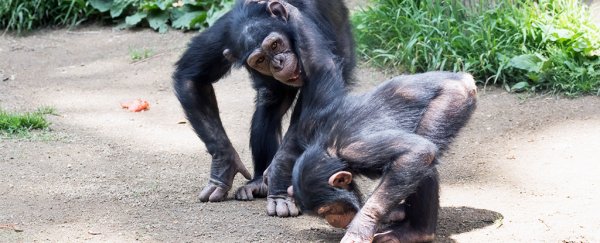Behind this sentence lies a solid bedrock of mathematics, one that has been shown to govern all human languages.
Linguists have found the hoots and hollers, gestures and expressions used by chimpanzees obey some of the same basic principles, demonstrating the foundations of language have deep evolutionary roots.
A study led by the University of Roehampton in the UK analysed hundreds of video recordings of chimpanzees living in Uganda's Budongo Forest reserve, categorising and measuring the characteristics of 58 types of playful gesture.
They were looking for hints of two rules common to all forms of human communication – Zipf's law of abbreviation, and Menzerath's law on the complexity of linguistic constructs.
Research had already been carried out on chimpanzee hooting and panting, showing these rules at work. But in closer quarters chimps communicate with more visual signs, leaving researchers a whole other linguistic system to analyse.
Zipf's law describes an inverse relationship between how often we use a word, and it's ranking in respect to other words. For example, the second most repeated word in any language will be used half as often as the first.
This quirk was figured out by a linguist named George Kingsley Zipf, who also noticed the higher a word happens to be in this list, the more abbreviated it happens to be.
Take the top five words in the English language as an example – the, be, and, of, and a. They're pretty snappy compared to the words ranked at 500 – value, international, building, and action.
This doesn't only apply to every other language spoken by humans; it's been shown to be at work in the vocalisations of macaques and dolphins, suggesting efficiency lies at the core of many forms of animal communication.
While we can now add the non-verbal communications of chimpanzees to that list, the evidence wasn't initially all that obvious.
The team found that among the 2,137 measured gestures there was no clear relationship between the duration of specific instances of each sign and its frequency of use.
Only when the gestures were categorised into groups and their duration then averaged out did strong patterns appear. Each expression type had a frequency, and it turns out the more often chimps used it, the shorter that group tended to be on average, following Zipf's law of abbreviation.
There was one interesting exception to the rule which involved whole body gestures. Here, the team found no evident correlation at all.
"Universal principles do not necessarily produce universal patterns," the researchers write, suggesting the law might still be at work on some level but masked by other driving forces.
Menzerath's law was similarly buried in the complex flurry of hand and foot sweeps and body posturing. This law states that large language structures are made of smaller ones. Long words, for example, have numerous components based on shorter, simpler terms.
As with Zipf's law of abbreviation, a comparison of groupings of gestures showed chimpanzees built long visual expressions from shorter units.
The statistical underpinnings of communication is referred to as quantitative linguistics. These rules are just two examples of a number of constraints, but both have in common the tendency to compress language into a more efficient form.
In other words, why would we – or chimpanzees, for that matter – put more effort into vocalising or gesturing than we'd need to?
While our primate cousins don't share our complex range of vocalisations, their mix of movements, sounds, and facial expressions are still constrained by time and energy, shaping a language into one that only works as hard as necessary.
The researchers are turning their sights onto bonobos next, curious to know how far we can expect these laws to permeate throughout the primate kingdom.
The work also has some implications for research on humans. Showing that the laws apply to gesture groupings rather than individual signs suggests there might be things we missed in our analysis of other forms of our own communication.
It also raises the question of just how universal these laws might be. Beyond the social glue that binds groups of macaques, dolphins, humans, and chimpanzees, hints of the laws can be found in the very chemistry of life, at a genetic level.
Could it also extend to life on other worlds? Maybe one day we'll discover just how universal the laws of language really are.
This research was published in Proceedings of the Royal Society B.
